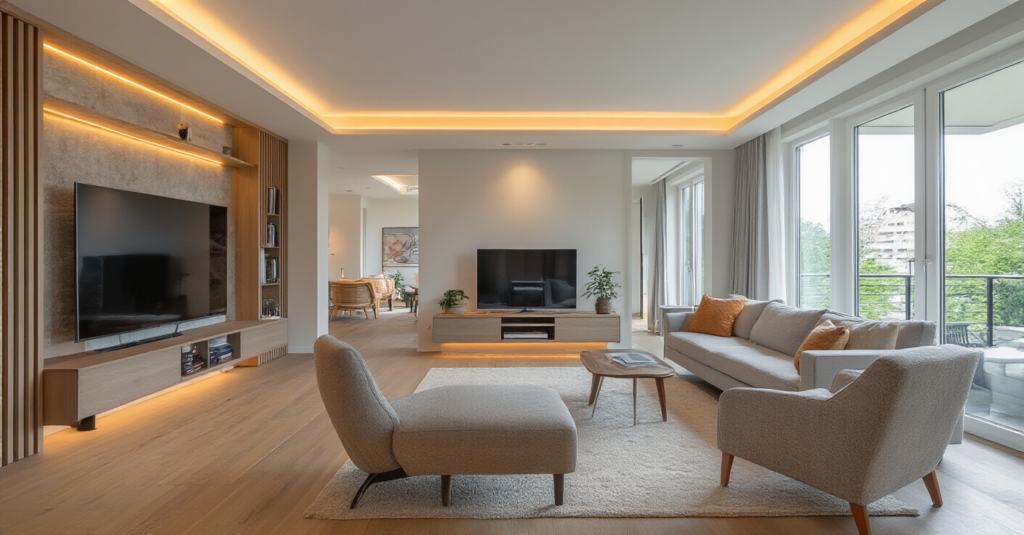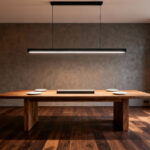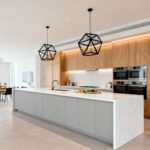You know what people always ask me? It’s not about the perfect shade of greige or the latest sofa trend. They say, “Jesse, my living room has to be an office, a playroom, and a place to relax. How do I stop it from looking like a chaotic mess?” They’re smart, they’re busy, and they’ve realized their living space is working against them, adding stress instead of reducing it. The glossy magazine photos and endless Pinterest boards are just noise—they don’t show you how to handle a Zoom call while a toddler builds a block tower a few feet away.
Let’s cut the corporate-speak and get real. Styling your living room isn’t about creating a perfect showroom. It’s about designing a high-functioning environment that supports your actual life, your work, and your well-being. It’s about making smart, intentional choices so your space feels cohesive and calming, not cluttered and draining. This is your command center. Let’s make it work for you, not the other way around.
Foundations & Vision: Laying the Groundwork
Before you buy a single pillow, we need a plan. Most design mistakes happen because people skip this part. They buy a piece of furniture they love and then try to force everything else to work around it. That’s backward. A solid foundation is about understanding how you need the room to perform first, then finding the style that supports it.
1. Analyze Your Living Room’s Functional Needs for Optimal Layout
Can we please stop buying furniture based on looks alone? I once had a client, a brilliant programmer, who bought this gorgeous, low-slung Italian sofa. It looked amazing. But he spent half his day working from it, and after two weeks, his back was a mess. He’d invested in a beautiful object that actively hurt his productivity and well-being. We had to rethink the entire room based on his actual daily activities, not just a fantasy of how he’d live.
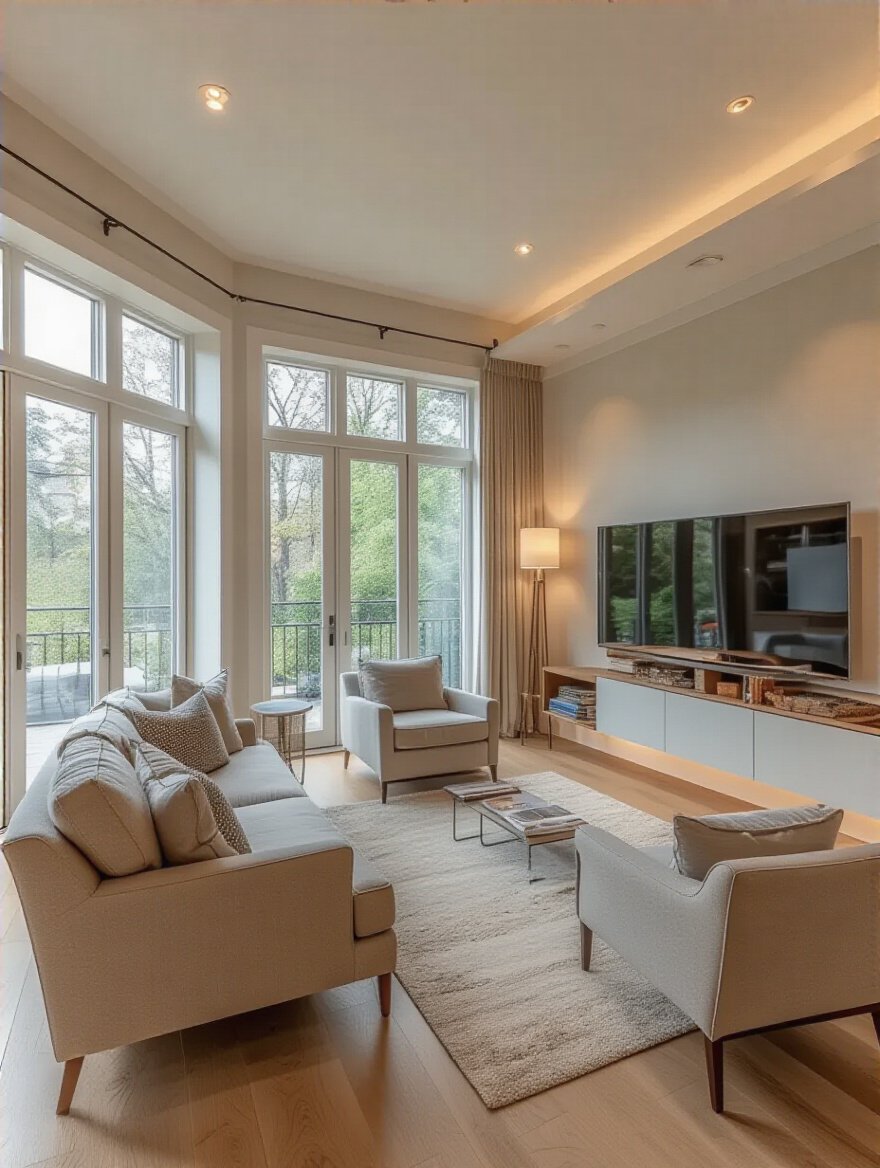
The real story is this: your living room has a job to do. Or, more likely, several jobs. Is it for watching movies? Hosting friends? Is it your primary workspace? A play zone for kids? Be brutally honest. Write down the top three to five things that actually happen in that room every day. This isn’t just noise; it’s the blueprint for everything else. Getting this right means you create a space that reduces daily friction, which makes you calmer, happier, and better at what you do.
Now that you know what the room needs to do, you can figure out how you want it to feel.
2. Discover Your Personal Style Through Inspiration Boards and Visual Cues
Everyone tells you to make a mood board, and honestly, most people do it wrong. They just pin a thousand random images on Pinterest and call it a day. That’s not a plan; it’s a digital hoarding habit. The shortcut I wish I’d known earlier is to look for the pattern. Go through your saved images and ask: What three things keep showing up? Is it a specific color, like deep green? A texture, like natural wood? A feeling, like bright and airy?
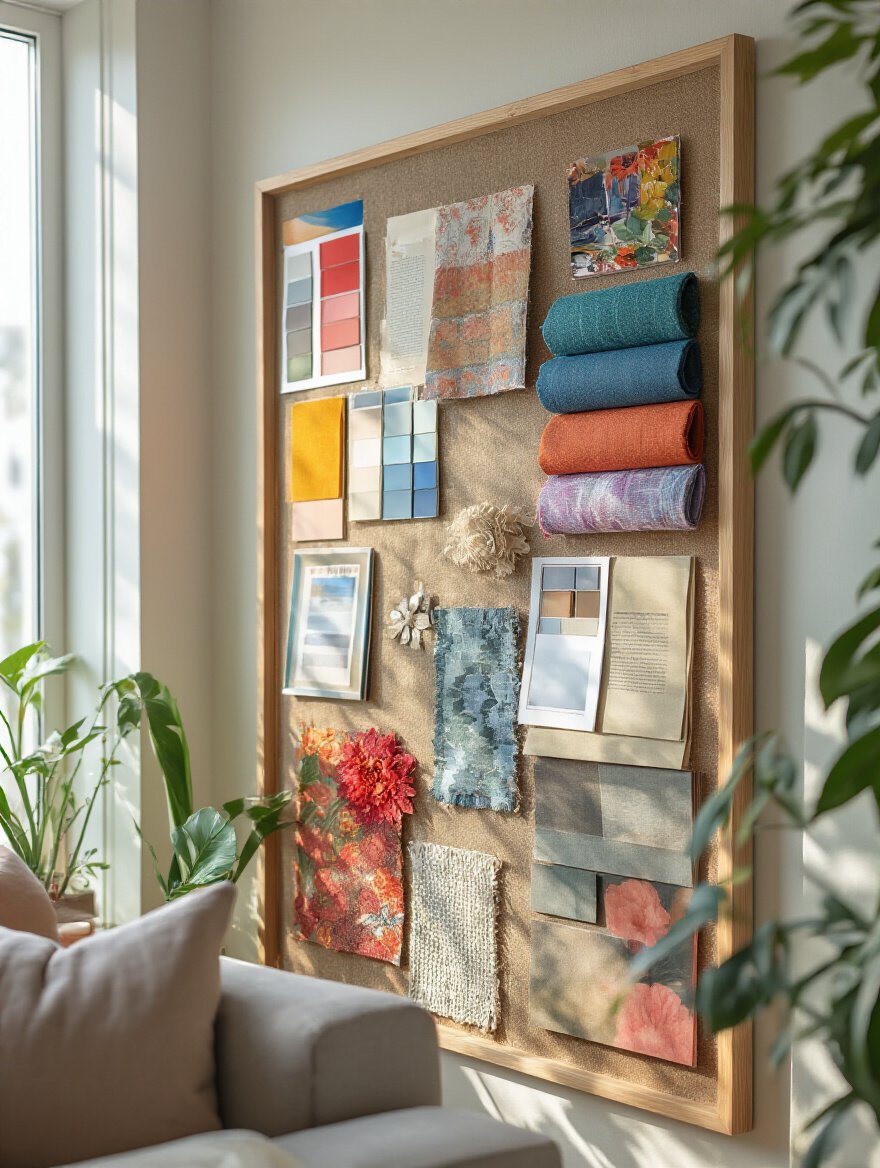
Don’t just collect pictures of living rooms. Look at fashion, at nature, at hotel lobbies you loved. When you find the recurring themes, you’ve found your true style, not just a trend you happen to like this week. This board is your filter. Before you buy anything, hold it up to the board and ask, “Does this fit my pattern?” It’s the single best way to avoid expensive mistakes and create a room that actually feels like you, not a carbon copy of a catalog.
With your vision clear, it’s time to face the unglamorous but critical reality of your actual space.
3. Master the Art of Space Planning with Room Dimension Mapping
Here’s my biggest pet peeve: people who “eyeball it.” No one’s eyeball is a calibrated laser measurer. You cannot guess the scale of a sofa you saw online and expect it to fit. Getting this wrong is the fastest way to turn your design dream into a logistical nightmare of return fees and awkward, cramped spaces. You need to map it out. Period.

Grab a tape measure—a laser one is even better—and get the dimensions of everything. The room, the windows, the doorways, and the fixed features like fireplaces or vents. Then, get a roll of painter’s tape and outline the furniture you’re considering on the floor. This is the ultimate shortcut. You can literally walk the path from the sofa to the door. You’ll see instantly if that coffee table is a shin-killer or if the armchair blocks the view. It feels a little silly, but it will save you so much money and frustration.
Once the physical footprint is mapped, we can paint it with a cohesive and calming palette.
4. Determine a Cohesive Color Palette for a Harmonious Foundation
Forget the “Color of the Year.” The right palette for your living room is one that supports its function and your mood. For years, office designers have known that color impacts focus and energy. You can use those same principles at home. If you work in your living room, a high-contrast, chaotic color scheme is just more visual noise for your brain to process. It’s draining. A cohesive palette, on the other hand, creates a sense of calm and order.

Here’s the only rule you need to know: the 60-30-10 rule. It’s a dead-simple recipe. 60% of your room is your main color (usually the walls). 30% is your secondary color (furniture, rugs). 10% is your accent (pillows, art, a cool vase). Pick a dominant color that makes you feel the way you want to feel in that space—calm, energized, focused—and build from there. Test paint swatches in your actual light, but trust this ratio. It works every time.
Now we can finally start putting things in the room.
Furniture & Layout Mastery: Practical Placement
Okay, you’ve got your plan. Now comes the physical part. This is where we turn that 2D floor plan into a 3D space that’s a pleasure to move through and live in. It’s about flow, scale, and making every piece of furniture pull its weight.
5. Optimize Furniture Placement for Effortless Traffic Flow and Conversation
Think about the path you walk most often in your living room. Is it a straight shot from the armchair to the kitchen for coffee, or is it an obstacle course around an awkwardly placed ottoman? Every time you have to awkwardly sidestep furniture, your brain registers a tiny hit of friction and stress. It sounds small, but it adds up over hundreds of trips a day. Good design removes that friction.
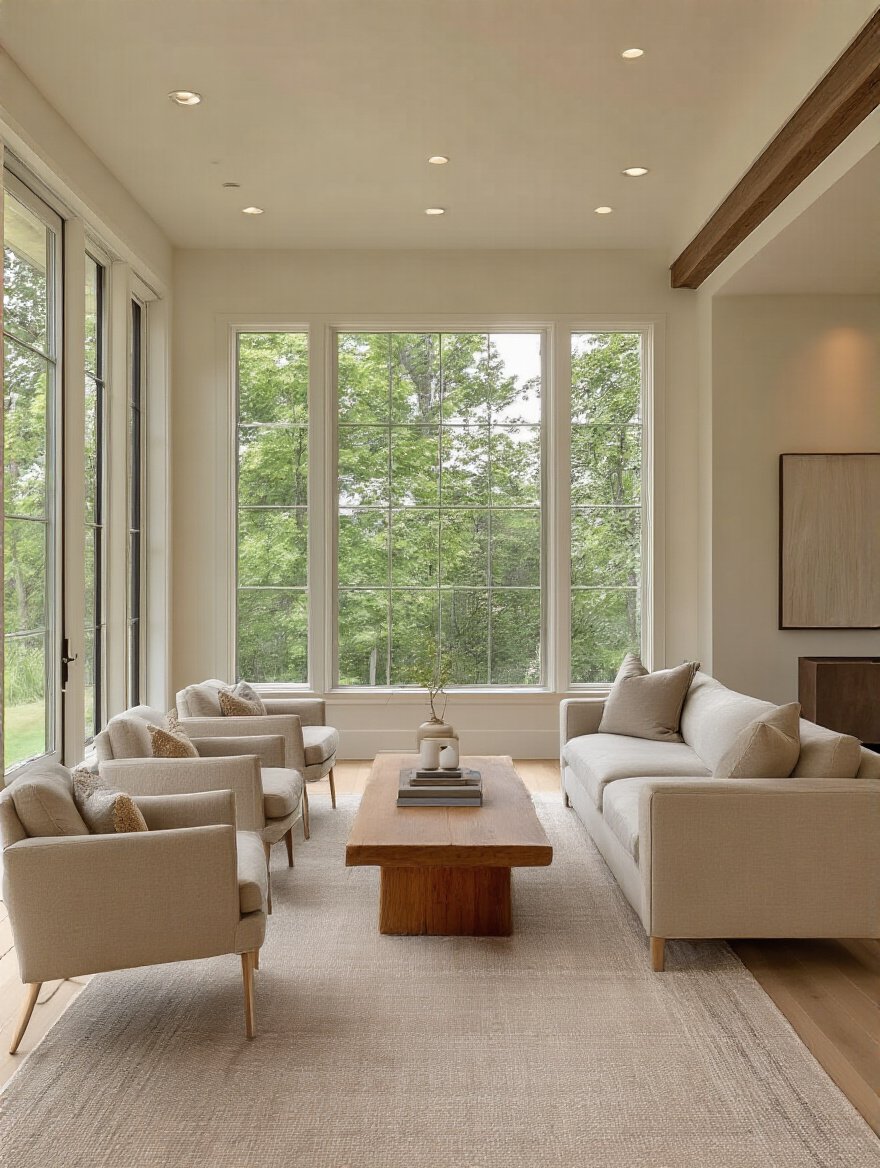
Map out your main travel lanes—to the door, to the window, to the kitchen—and keep them at least three feet wide. No exceptions. Then, arrange your seating to create a “conversation nest.” This just means people should be able to talk without shouting across a canyon. It fosters connection. More importantly for home-based professionals, it creates defined zones that help you mentally separate “work” from “life,” even if they’re happening in the same room.
Good flow is a great start, but it means nothing if the furniture itself is all wrong for the space.
6. Choose Right-Sized Furniture to Avoid Overcrowding or Under-Furnishing
Everyone gets scale wrong. They fall in love with a giant, pillowy sectional and cram it into a small apartment, leaving no room to breathe. Or they put tiny, delicate furniture in a huge room with vaulted ceilings, and it looks like dollhouse furniture. Your furniture needs to be in proportion to the room and to the other pieces in it. This is non-negotiable for a room that feels balanced and calm.
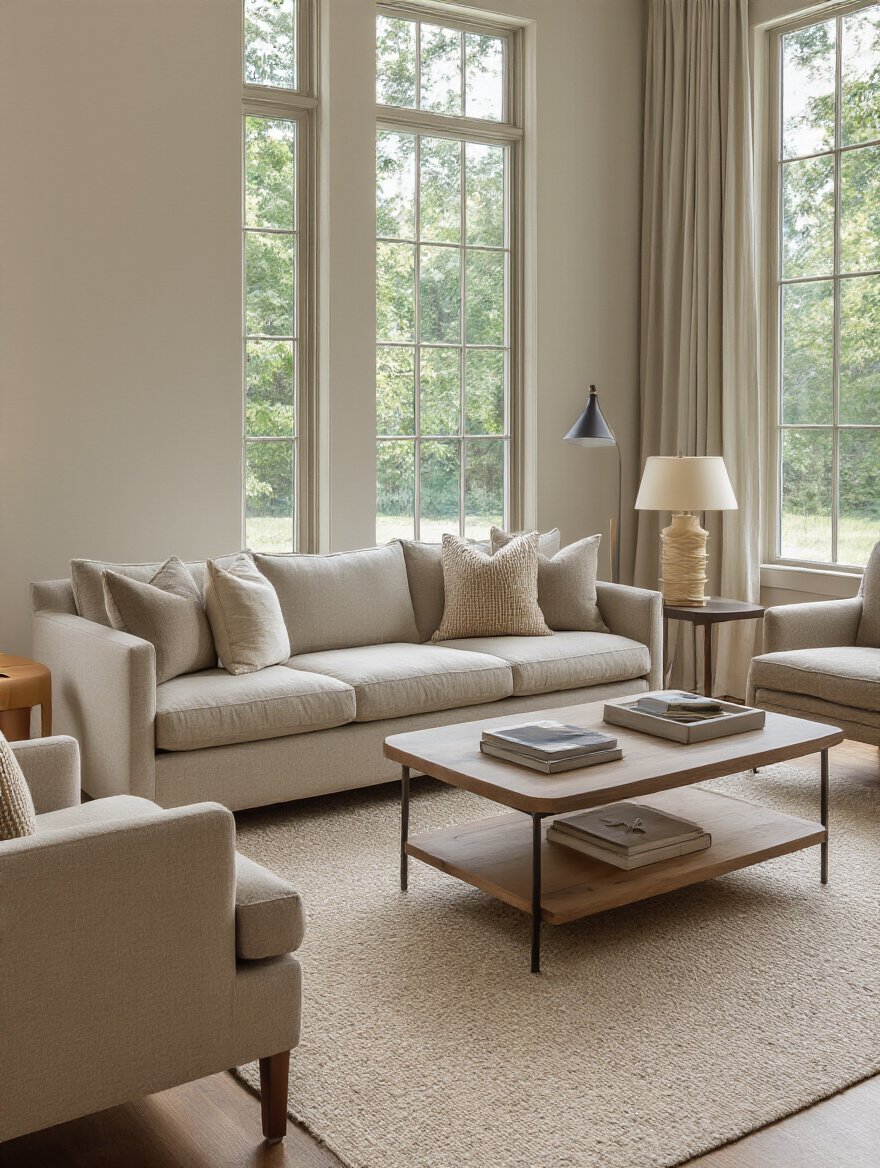
The secret is negative space. The empty space around your furniture is just as important as the furniture itself. It gives your eyes a place to rest and makes the room feel larger and more intentional. A great shortcut is to choose furniture with visible legs. A sofa or chair that’s lifted off the floor, even by a few inches, creates an illusion of more space because you can see the floor underneath. It’s a simple trick that massively impacts how large and airy a room feels.
In smaller rooms especially, every piece needs to do more than one job.
7. Integrate Versatile multi-functional pieces to Maximize Small Spaces
If you’re working from home in a small space, multi-functional furniture isn’t a cute trend; it’s a survival strategy. You’re asking one room to do the job of three, so your furniture needs to be just as hardworking. This is about maximizing the return on investment for every square foot you have. It’s the key to making a small space feel capable and uncluttered.
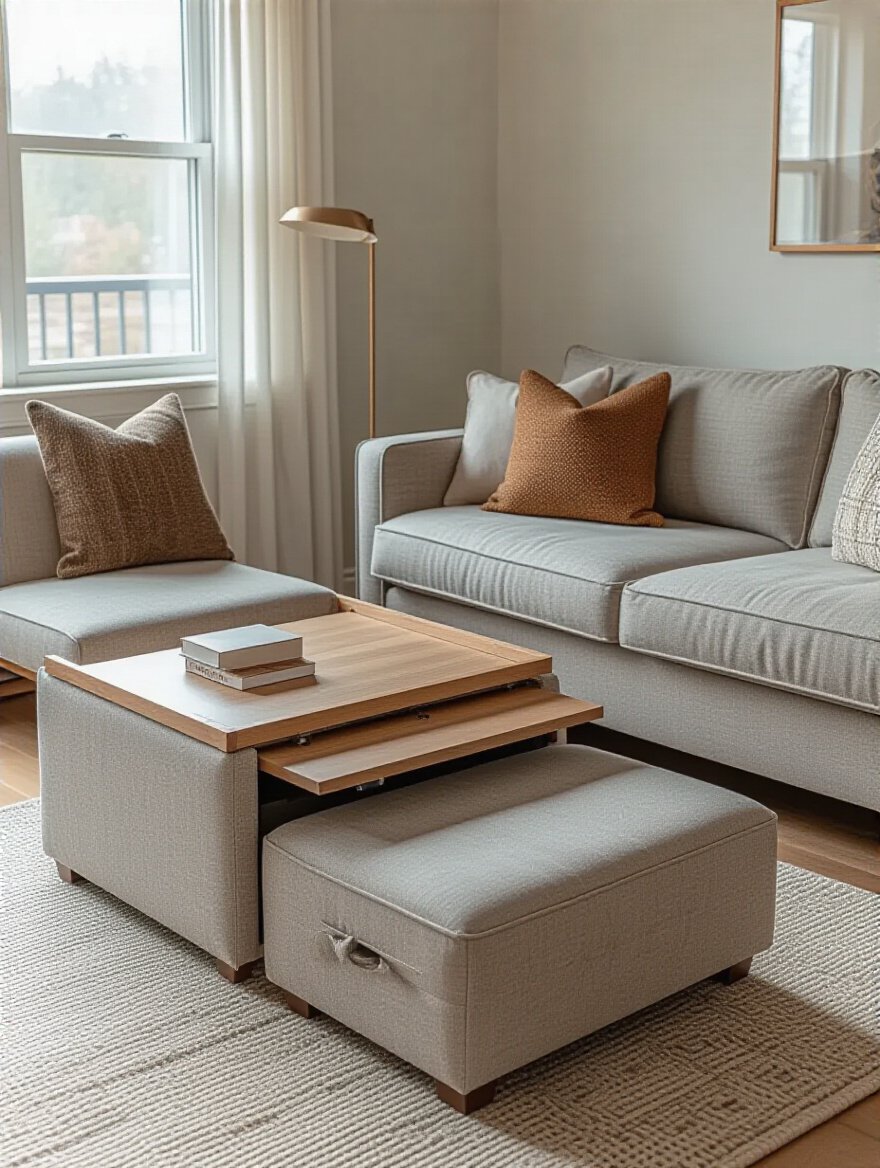
I’m a huge fan of coffee tables with lift-tops that become desks. They’re perfect for occasional work without dedicating a whole corner to a formal desk. Storage ottomans are brilliant—they hide your clutter, serve as a footrest, and can even be extra seating when guests come over. A slim console table behind a sofa can be a landing strip for your keys, a serving surface for drinks, or a shallow-depth workspace in a pinch. Think like a designer for a tiny house: how can one piece solve two or three problems?
Now, let’s make those pieces work together to create an inviting atmosphere.
8. Create Intimate Conversation Zones with Thoughtful Furniture Grouping
Even if you live alone, creating a “conversation zone” is critical. It sounds like something for party hosts, but what it really means is creating an intentional focal point. When furniture is just pushed up against the walls, the room feels like a waiting room—temporary and disconnected. Pulling your furniture together into a defined group, usually anchored by an area rug, makes it feel purposeful and grounded.

For remote workers, this is a psychological game-changer. You can create a small “work zone” with an armchair and a small table, and a separate “relaxation zone” with your sofa and coffee table. Even if they are only a few feet apart, the visual separation helps your brain switch gears. A client of mine with a studio apartment used a small area rug and a comfortable chair to create a “reading nook” that was her dedicated non-work, non-sleep space. It dramatically improved her ability to disconnect at the end of the day.
With the layout mastered, it’s time to layer in the elements that create a mood.
Atmosphere & Depth: Color, Texture & Lighting
This is the part that transforms a well-arranged room into a space with soul. It’s less about rules and more about orchestrating a sensory experience. If the layout is the skeleton, this is the part that gives it warmth and personality.
9. Select Paint Colors That Enhance Mood and Room Perceived Size
Paint isn’t just decoration; it’s a tool. It’s the cheapest, fastest way to completely change the energy of a room. Light, cool colors (soft blues, greens, greys) literally feel like they are receding, making a small room feel bigger and more airy. This is a great choice if you ever feel claustrophobic while working from home.

Conversely, dark, warm colors (deep navy, charcoal, rich terracotta) can make a large, cavernous room feel cozier and more intimate. A darker color can also be incredible for focus—think of a cozy, wood-paneled library. A friend of mine painted the wall behind his monitor a deep charcoal gray. He said it helped his screen “pop” and reduced the visual distractions around his workspace, allowing him to concentrate better. That’s design doing a job.
Next, we need to make sure the room doesn’t feel flat or one-dimensional.
10. Incorporate Diverse Textures to Add Visual Interest and Cozy Warmth
A room with only smooth, flat surfaces—like a leather sofa, a metal coffee table, and a short-pile rug—can feel cold and sterile, like a corporate lobby. Texture is what makes a space feel inviting and comfortable. It’s the difference between a room you look at and a room you want to curl up in. The best-designed spaces are a mix of hard and soft, rough and smooth.
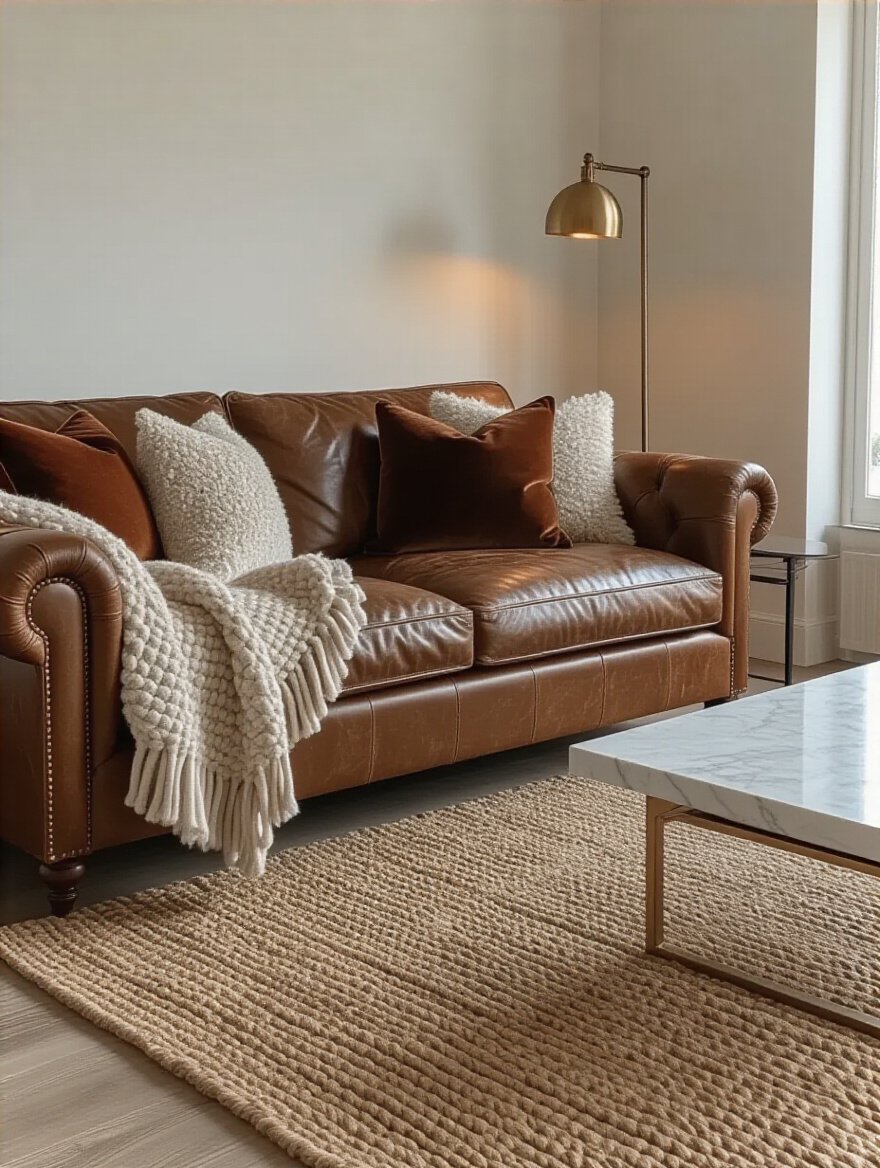
This is easy to do. Think about adding a chunky knit throw over the arm of your sleek sofa. Place a rough-hewn wooden bowl on a polished marble table. Pair a soft velvet pillow with a sturdy linen one. These contrasts create visual interest and tactile richness. They signal to your brain that this is a place for comfort, which is crucial for de-stressing after a long day of work.
No matter how great your textures are, they’ll fall flat without the right light.
11. Design a Layered Lighting Plan for Ambience and Task Functionality
Having only one harsh overhead light is a cardinal sin of interior design. It creates unflattering shadows and does nothing to support the different activities in your room. A good lighting plan is layered, just like the rest of your design, and it’s one of the biggest factors in productivity and comfort. You need three types of light, and it’s not complicated.
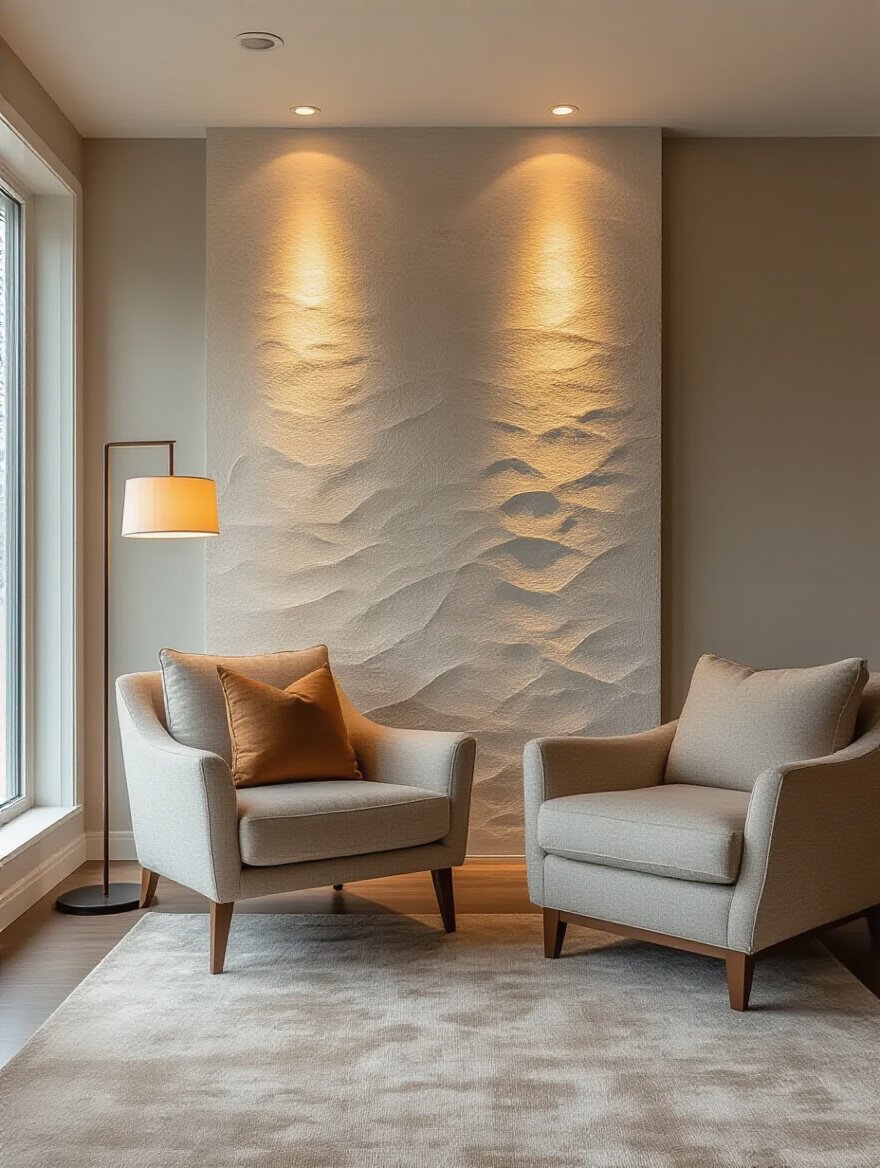
First is Ambient light: this is your overall illumination, the main overhead light. Put it on a dimmer. Second is Task light: this is targeted light for a specific activity. It’s the floor lamp next to your armchair for reading, or the desk lamp you use for focused work. Good task lighting is non-negotiable for preventing eye strain and headaches. Third is Accent light: this is the fun stuff. A small spotlight on a piece of art or an uplight behind a plant. It adds depth and mood. Having all three, and being able to control them separately, gives you complete control over the room’s function and feel.
Now let’s add a little bit of personality.
12. Introduce Pop Accents with Contrasting Colors or Statement Pieces
Here’s the BS everyone tells you: “Just add a pop of color!” A single, lonely, bright-yellow pillow on a grey sofa looks like an accident. An intentional pop accent is different. It’s a deliberate, confident choice that’s repeated in a small, controlled way to guide the eye and add energy to a space. It’s the quickest way to make a neutral room feel custom and dynamic.

The shortcut is the ‘Rule of Three’. If you want to introduce a pop of, say, sapphire blue, don’t just use one pillow. Use a pillow, a small vase on the bookshelf, and a touch of that same blue in a piece of art on the wall. The repetition makes it look purposeful, not random. This is how you add personality without creating chaos. A statement piece—like a wild piece of art or a uniquely shaped chair—can achieve the same thing all on its own.
There’s one more trick for adding life and energy, and it’s practically magic.
13. Strategically Use Mirrors to Amplify Light and Expand Small Rooms
Mirrors are the secret weapon of interior design. They’re basically portable windows. Placing a large mirror opposite a window can literally double the amount of natural light in a room, which is a massive win for your mood and your electricity bill. More light means less eye strain during the workday and a more positive, energetic atmosphere overall.
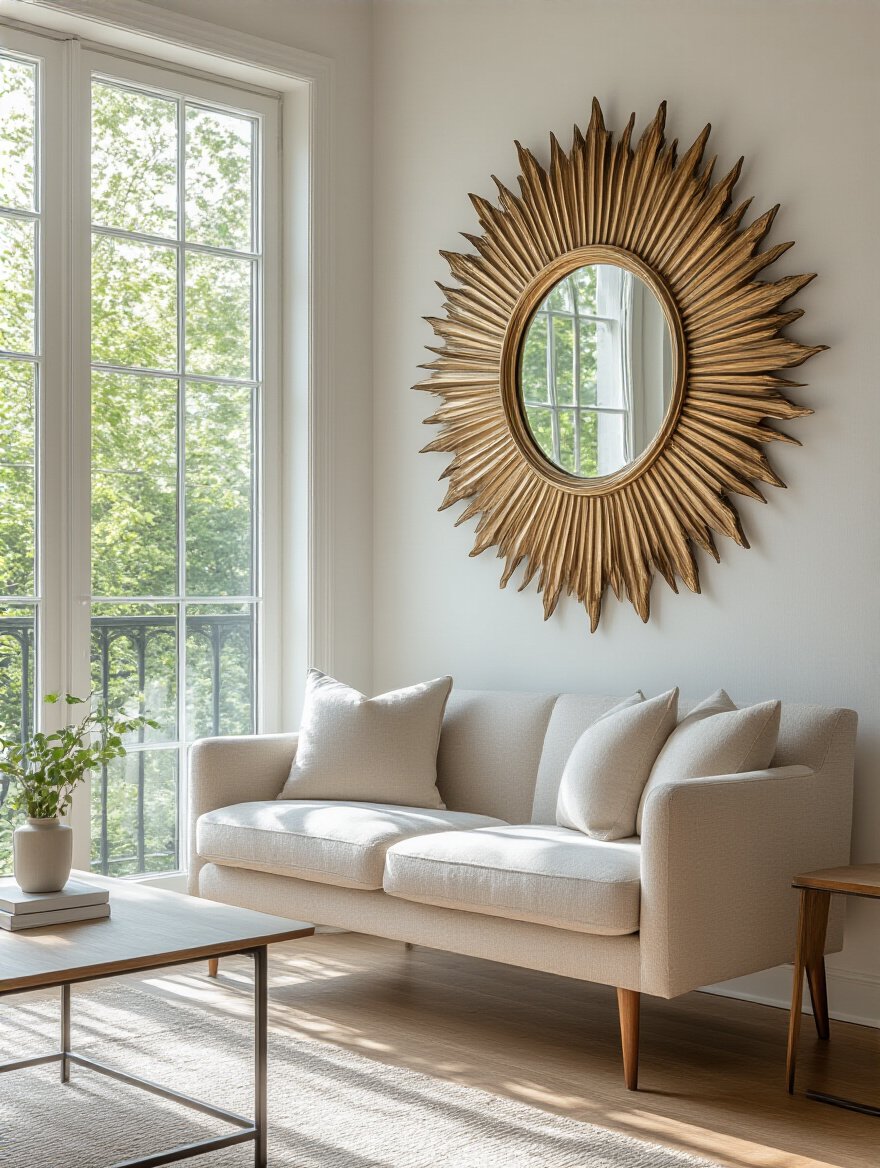
They also create the illusion of depth. In a small or narrow room, a large mirror on one wall can make the space feel significantly larger and less confining. A client in a narrow city apartment hung a huge floor-to-ceiling mirror along one of the long walls of his living room. He said it instantly cured his feeling of being “in a hallway” and made his workspace feel expansive and open.
With the big-picture items in place, let’s zoom in on the details that make a room truly yours.
Personal Touch: Accessorizing & Artful Curation
This is where your living room stops looking like a catalog and starts telling your story. Furniture and layout are the foundation, but the personal layers are what give a space its soul. This is about being a curator of your own life.
14. Curate Meaningful Artwork and Photo Galleries for Personality
Please, no more generic “Live, Laugh, Love” signs. Your walls are prime real estate for expressing who you are. This isn’t about buying expensive, investment-grade art. It’s about surrounding yourself with images that have meaning to you. It could be a gallery wall of your travel photos, your kids’ drawings in nice frames, or a large print from an artist you discovered online.
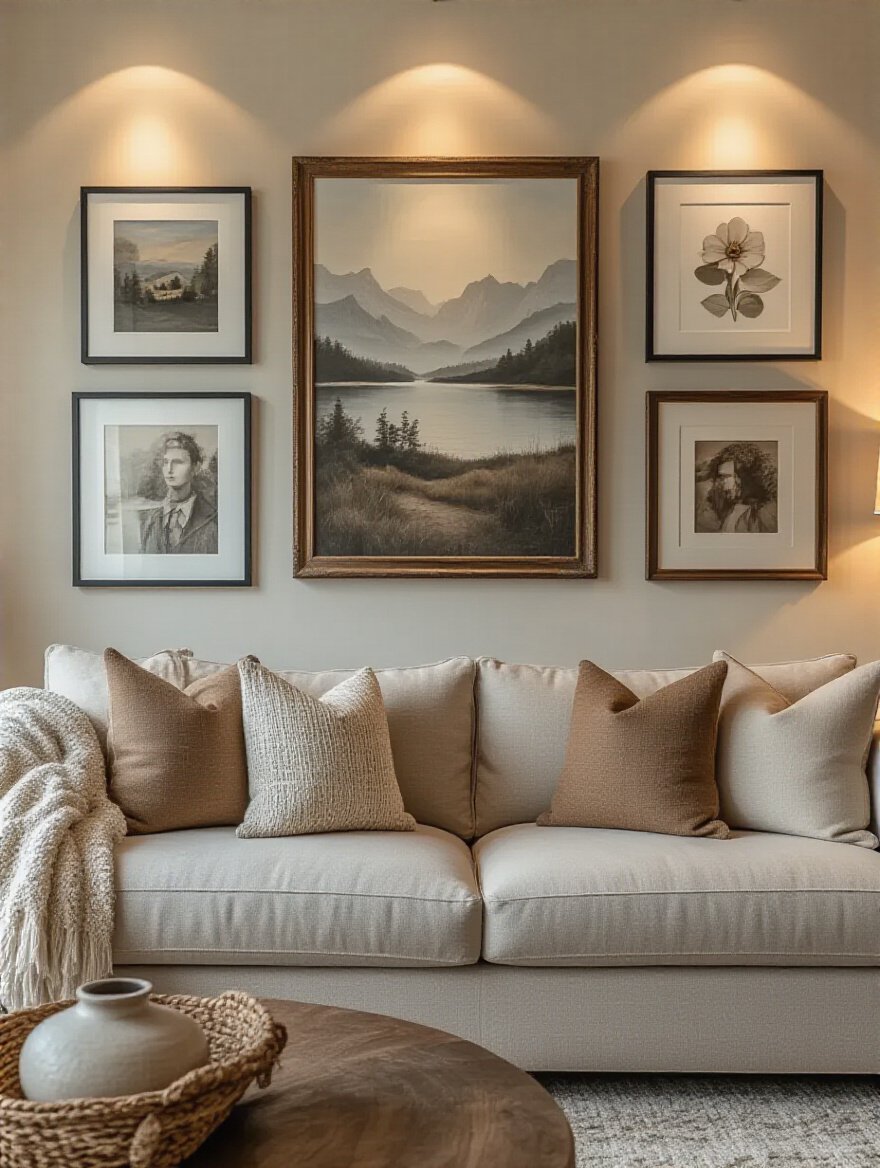
A well-designed space should energize you, and personal art is a huge part of that. Every time you glance up from your laptop and see a photo from a favorite trip, you get a tiny mental boost. It connects you to your life outside of work and reminds you of what you’re working for. That’s a powerful tool for well-being that generic “hotel art” just can’t provide.
Now, let’s apply that same personal touch to your surfaces.
15. Elevate Style with Thoughtfully Arranged Decorative Accessories
This is what separates the amateurs from the pros. Don’t just put stuff on shelves. Curate them. These small arrangements, or “vignettes,” are what make a room feel finished and polished. The key is to stop thinking about individual objects and start thinking about creating balanced groups. The noise is having a cluttered surface; what matters is creating a single, cohesive statement.
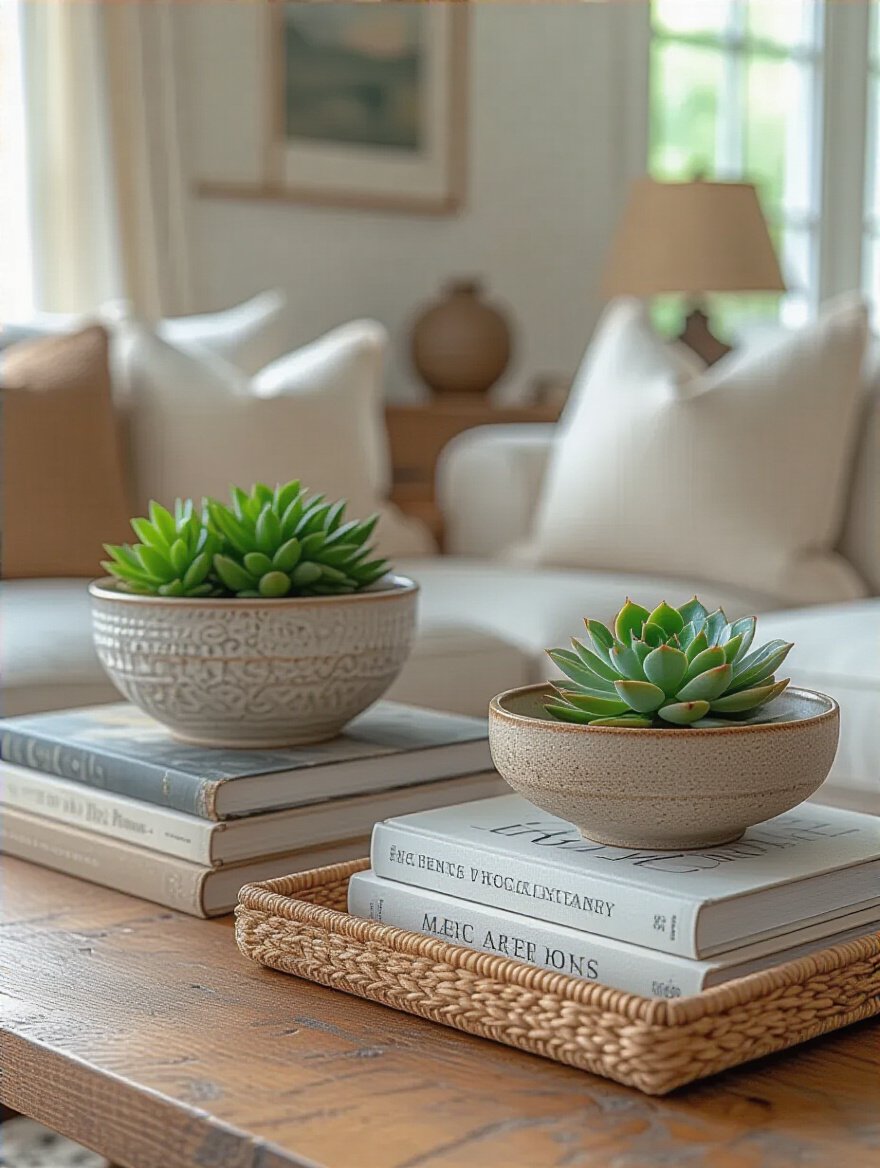
Here’s the pro shortcut: On any surface (a coffee table, a bookshelf), create a group of three objects. Vary their height and texture. A classic combo is a stack of books (horizontal), a tall vase (vertical), and a small, interesting object (sculptural). This creates a visual triangle that is pleasing to the eye and looks effortlessly stylish. And remember, negative space is your friend. A few well-placed, beautiful things are far more impactful than a hundred random trinkets.
One of the best accessories you can add is something that’s alive.
16. Incorporate Greenery with Live Plants for Freshness and Vitality
Bringing plants into your living room is one of the single most effective things you can do for the space and for your own well-being. It’s not just that they look good; it’s biophilia—our innate human need to connect with nature. Studies have shown that having plants indoors can reduce stress, improve concentration, and even purify the air. For anyone working from home, this is a no-brainer.
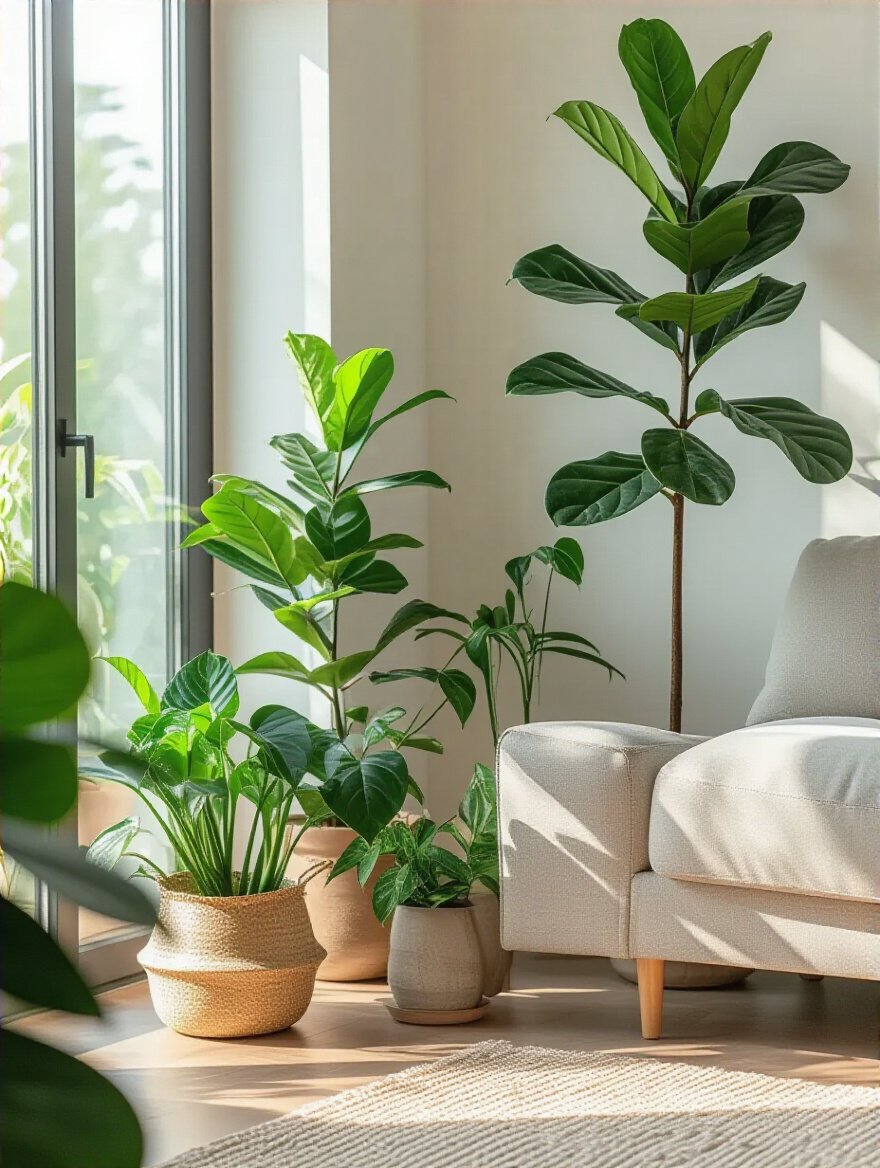
If you think you have a “black thumb,” you’re just buying the wrong plants. Start with something indestructible like a Snake Plant or a ZZ Plant. They thrive on neglect. Placing a large plant in a corner can add drama and architectural interest, while a few small succulents on a shelf can add a touch of life. They make a space feel more vibrant, healthier, and calmer. It’s an investment in your sanity.
Now for the final layer of softness and comfort.
17. Arrange Pillows and Throws to Add Comfort and Visual Cohesion
Pillows and throws are the jewelry of a living room. They are the fastest, cheapest, and easiest way to change the entire vibe of the space. You can swap them out seasonally to make the room feel cozier in the winter and lighter in the summer. They are your best tool for tying your color palette together. Pull an accent color from your rug or a piece of art and repeat it in your pillows. Instantly, the room feels more cohesive.
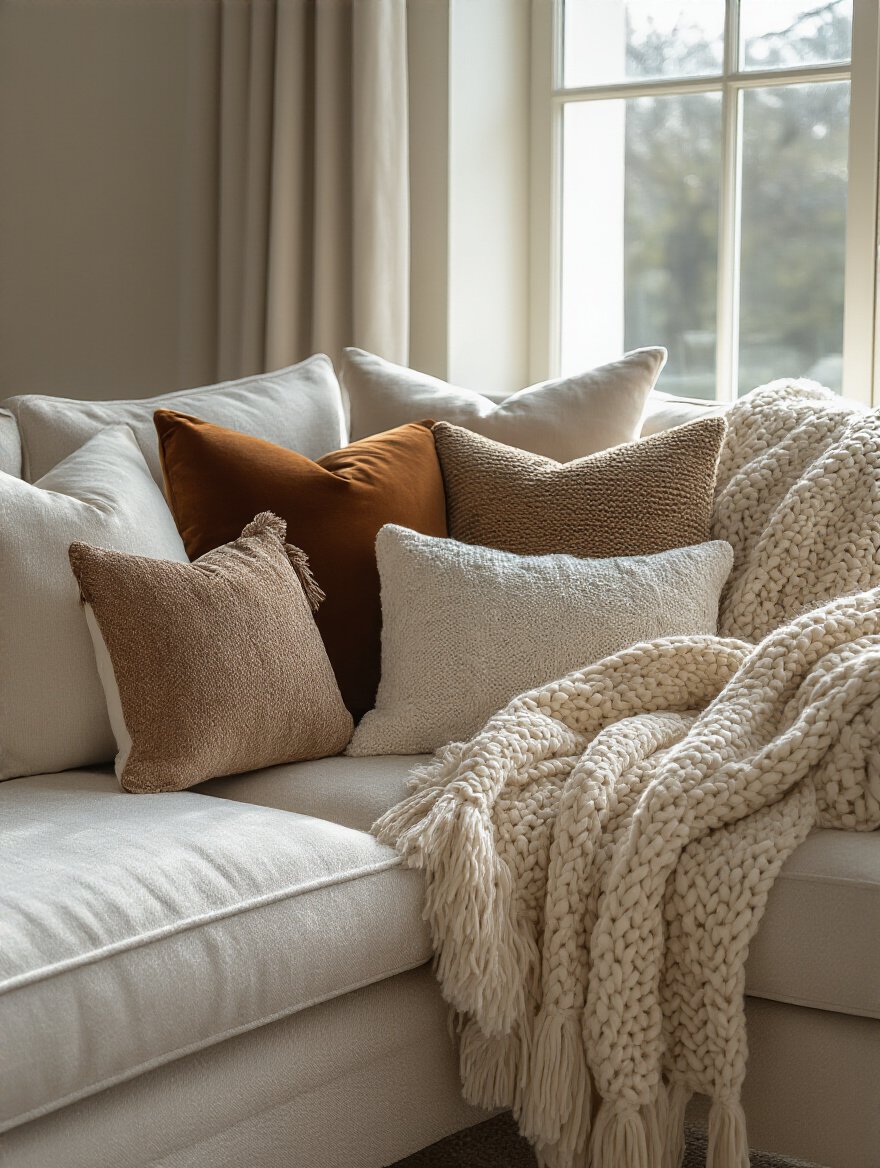
Here’s the inside scoop: the insert matters more than the cover. Cheap polyester-filled pillows look stiff and sad. Invest in feather-down inserts (you can find them affordably online). They look much more plush and inviting and give you that satisfying “karate chop” look you see in magazines. And when you drape a throw, don’t fold it perfectly. Casually toss it over the arm or back of the sofa. It should look like someone actually lives there.
Finally, let’s anchor the entire room and define your space.
18. Select Area Rugs to Define Zones and Anchor Furniture Groupings
An area rug is not a bath mat. Using a rug that’s too small is the most common design mistake I see, and it makes me crazy. It makes your entire room look disjointed and your furniture look like it’s floating in a sea of flooring. The rug is the “fifth wall”; it should be the anchor that pulls your entire furniture grouping together into one cohesive unit.

The rule of thumb is simple: at least the front two legs of your sofa and all of your chairs should be sitting on the rug. If you can fit all four legs of every piece on the rug, even better. In an open-concept space or a studio apartment, a rug is the clearest way to say, “This is the living area,” and “That is the dining area.” It defines the zone without needing walls, bringing order and clarity to the space, which is critical for mental focus.
Your room is styled. Now, how do you keep it that way?
Refinement & Evolution: Elevating Your Style
A well-designed room isn’t static; it evolves. The final stage is about maintaining the balance and polish you’ve created, and knowing how to refresh it without starting from scratch. It’s about keeping your space feeling alive and responsive to your life.
19. Apply the Rule of Three for Balanced and Visually Appealing Vignettes
We touched on this before, but it’s a rule worth repeating because it’s a designer’s secret handshake. Our brains are wired to find groupings of odd numbers, especially three, more appealing and natural than even numbers. Two objects can create a rigid, boring symmetry. Four can feel cluttered. But three? Three creates a sense of dynamic balance.
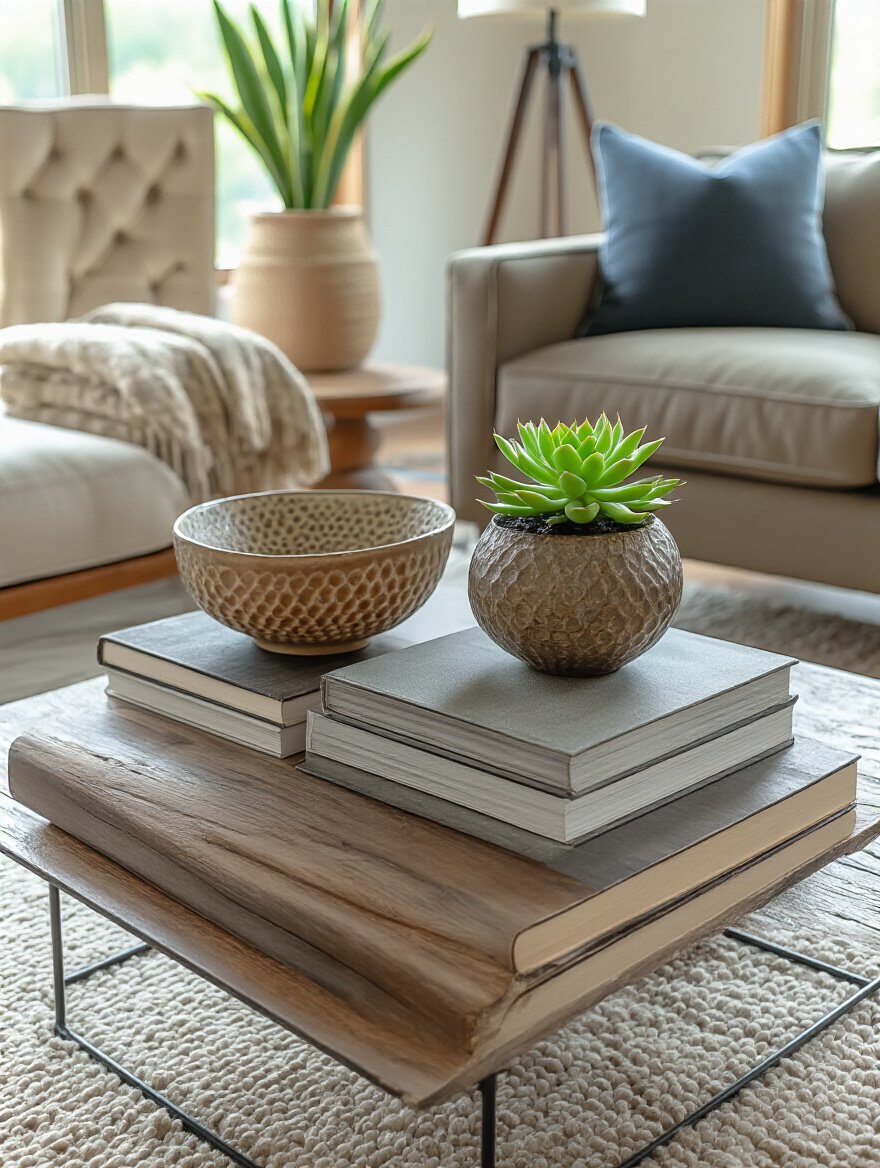
Apply this everywhere: three pillows on one side of the sofa, a cluster of three vases on the mantelpiece, a group of three framed photos on a side table. Just remember to vary the height and scale within the group to make it interesting. Once you start seeing in threes, you’ll never be able to unsee it, and styling any surface will become second nature. It’s a simple framework that makes you look like a pro.
This rule helps you style what’s out, but what about managing the rest?
20. Declutter and Organize Smartly for a Polished, Serene Environment
Clutter is postponed decisions. Every object lying around that doesn’t have a home is another piece of visual noise competing for your attention. From a productivity standpoint, this is a disaster. Your brain has to constantly work to filter out the mess, which drains your cognitive resources and leaves less energy for focused work. A clear space equals a clear mind.

Smart organization isn’t about hiding your mess; it’s about eliminating it. First, be ruthless. If you don’t use it, need it, or absolutely love it, it doesn’t belong in your living room. Then, give everything that remains a dedicated “home.” Use decorative boxes on shelves, a basket for blankets, and a tray on your ottoman for remotes. My favorite trick for preventing clutter from creeping back is the ‘one-in, one-out‘ rule. For every new thing you bring into the room, one old thing has to leave. It’s a simple system for maintaining balance forever.
Your space is now balanced and decluttered. Here’s how to keep it fresh.
21. Refresh Your Look Seasonally with Simple, Impactful Decor Swaps
When you work from home, you see the same four walls a lot. It’s easy to get decor fatigue, where your own space starts to feel stale and uninspiring. The solution isn’t a massive renovation every year. It’s a simple, seasonal refresh that takes less than an hour and makes a huge impact. This is the ultimate sustainable styling tip.
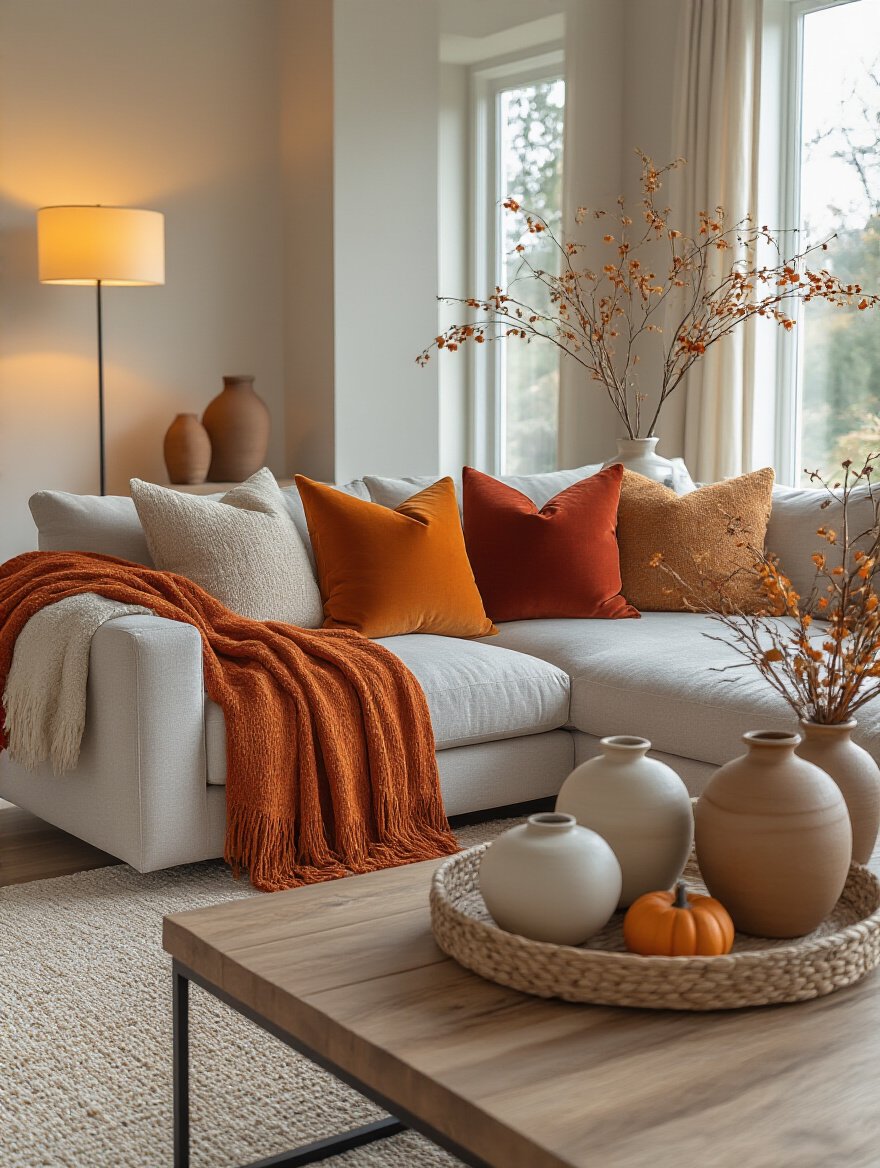
Think of it this way: your furniture is your “core wardrobe,” and your accessories are the seasonal updates. In the fall, swap your light cotton pillows for rich velvet or wool ones in deeper colors. Trade out a floral print for a more abstract, moody piece of art. Bring in a candle with a warm, spicy scent. These small, inexpensive swaps make your home feel in sync with the world outside and give you a dose of novelty that keeps the space feeling fresh and exciting.
Your Space, Your Rules
So there you have it. You’ve gone from the big-picture foundation to the small, personal details. The goal of all these tips isn’t to create a “perfect” living room according to some magazine’s standards. The goal is to create a living room that perfectly supports your life. A space that helps you be more productive when you need to work, more relaxed when you need to unwind, and more connected to the people and things you love.
Don’t get overwhelmed and try to do all 21 things at once. Pick one. Start with the painter’s tape trick, or just go buy a Snake Plant. Every small, intentional choice you make will build on the last, reducing the friction in your daily life and making your home a place of genuine support and comfort. You have the blueprint. Now go build a space that truly works for you.
